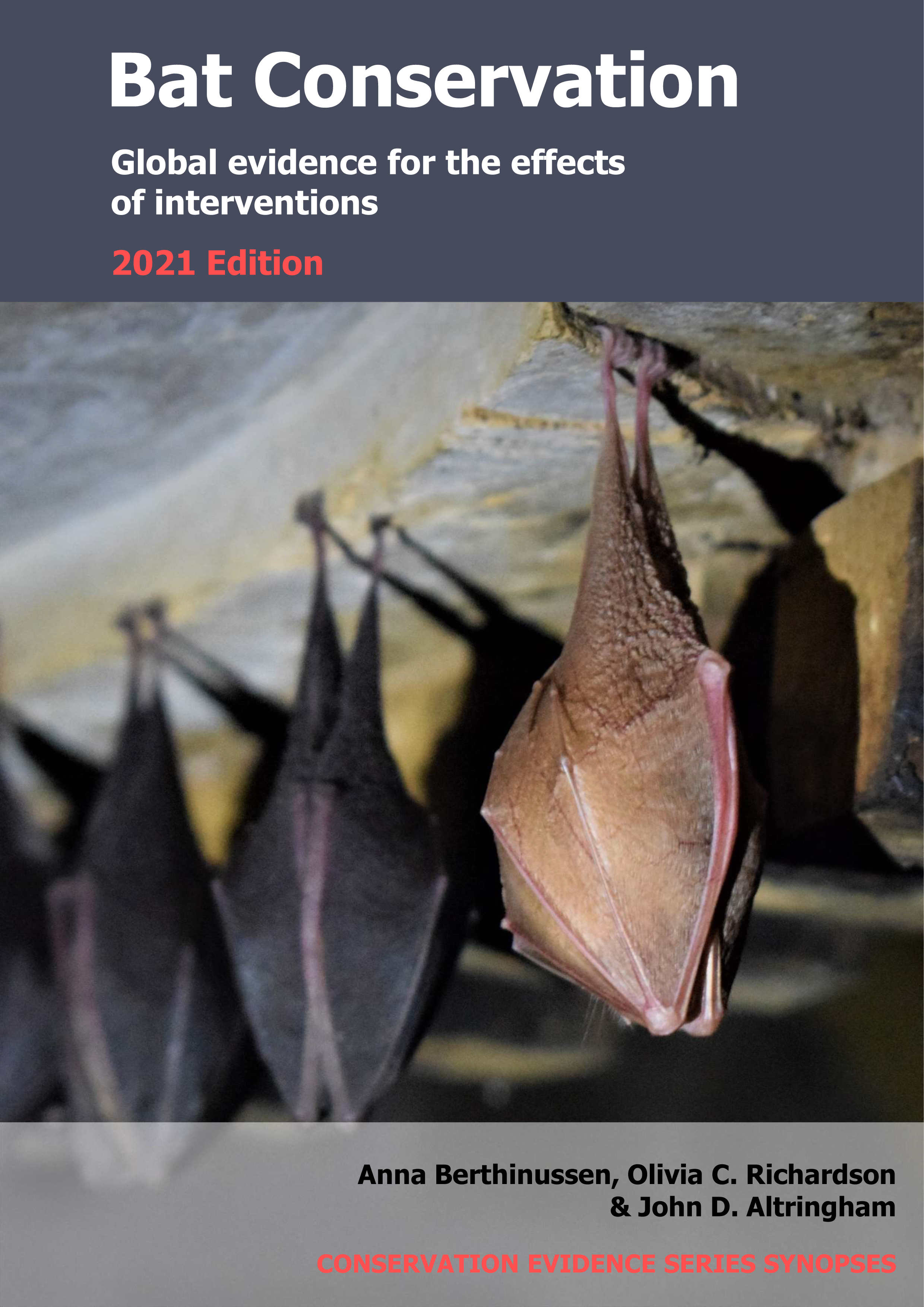Create or restore bat foraging habitat in urban areas
-
Overall effectiveness category Unknown effectiveness (limited evidence)
-
Number of studies: 3
View assessment score
Hide assessment score
How is the evidence assessed?
-
Effectiveness
60% -
Certainty
36% -
Harms
0%
Study locations
Supporting evidence from individual studies
A site comparison study in 2004–2005 in nine forest fragments within the Chicago metropolitan area, USA (Smith & Gehrt 2010) found that two of seven restored forest fragments had higher bat activity than two unrestored forest fragments. Bat activity was higher in two forest fragments that had been restored with multiple prescribed burns, invasive plant species removal and snag recruitment (average 7–19 bat passes/survey) than in two control sites with no restoration (average 1–4 bat passes/survey). Bat activity was similar between control sites and five other forest fragments that had been restored with multiple prescribed burns and various combinations of invasive species removal, snag recruitment and deer population control (1–6 bat passes/survey). Six bat species were recorded in total (see original paper for data for individual species). Fire suppression over the last 100 years had altered the structure of the nine forest fragments (10–260 ha in size). Seven of the nine forest fragments were being restored to open the canopy, reduce tree density and remove invasive plant species. At each of nine sites, four bat detectors recorded bat activity for 4 h from sunset for five nights/year in June–September 2004 and May–August 2005.
Study and other actions testedA replicated, controlled, site comparison study in 2010 of 39 green roofs in Greater London, UK (Pearce & Walters 2012) found that ‘biodiverse’ green roofs had higher bat activity than conventional roofs, but ‘sedum’ green roofs had similar or lower bat activity than conventional roofs. When a small amount (<33%) of natural foraging habitat was located within 100 m of roofs, bat activity was higher over ‘biodiverse’ green roofs (average 7 bat passes/night) than conventional roofs (average 1.3 bat passes/night), and similar over ‘sedum’ green roofs (average 1 bat pass/night) and conventional roofs. However, when higher amounts of natural habitat cover were located within 100 m of roofs (33–66%), bat activity was similar between ‘biodiverse’ green roofs (average 10 bat passes/night) and conventional roofs (average 12 bat passes/night), and lower over ‘sedum’ green roofs (average 4 bat passes/night). Four bat species or species groups were recorded in total (see original paper for data for individual species). All green roofs had shallow substrate (20–200 mm). ‘Biodiverse’ roofs were planted with a variety of wild flowers, herbs, sedums, mosses, and grasses. ‘Sedum’ roofs were planted with low-growing succulent plants. Conventional roofs were flat or shallow pitched with bitumen felt or paving slabs. Bat activity was recorded over each of 13 biodiverse, nine sedum and 17 conventional roofs for seven full nights in May–September 2010.
Study and other actions testedA replicated, controlled, paired sites study in 2013 of four paired roofs in New York City, USA (Parkins & Clark 2015) found higher activity over green roofs than conventional roofs for three of five bat species, but no difference in species richness. Five bat species were recorded over both green and conventional roofs. The average number of bat passes/night was higher over green roofs than conventional roofs for the eastern red bat Lasiurus borealis (green: 253; conventional: 128), big brown bat Eptesicus fuscus (green: 11; conventional: 0.6), and tricoloured bat Perimyotis subflavus (green: 12; conventional: 2). The average number of bat passes/night was similar over green and conventional roofs for the hoary bat Lasiurus cinereus (green: 56; conventional: 57) and silver-haired bat Lasionycteris noctivagans (green: 33; conventional: 24). Paired roofs were six or eight stories high and were located within one block of each other. One of each pair was a green roof with a waterproof membrane with growing substrate covered in vegetation. The other of each pair was a conventional roof with a ‘blacktop’ or concrete roofing material with no vegetation. Bat activity was recorded between May and September in 2013 with a bat detector deployed in the centre of each roof.
Study and other actions tested
Where has this evidence come from?
List of journals searched by synopsis
All the journals searched for all synopses
This Action forms part of the Action Synopsis:
Bat Conservation
Bat Conservation - Published 2021
Update 2020





)_2023.JPG)














